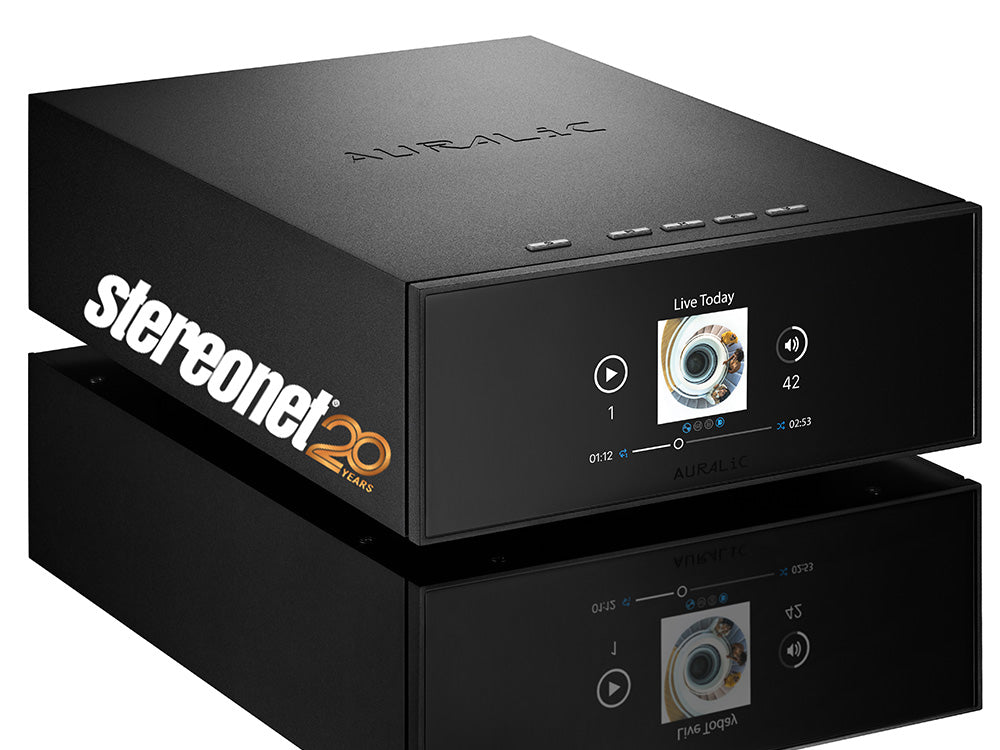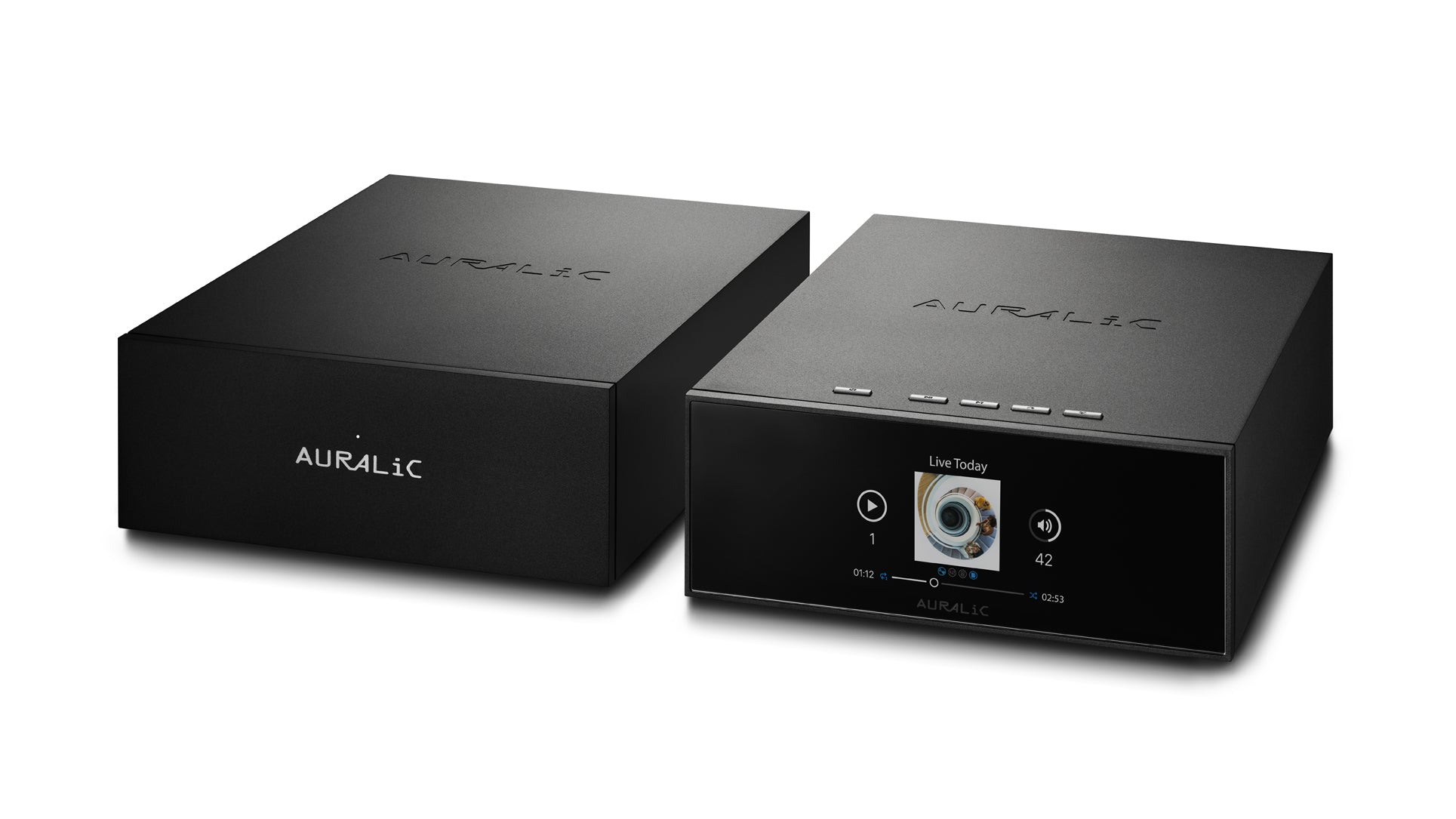
ARIES S1 Review by StereoNet
Original Review: https://www.stereonet.com/uk/reviews/auralic-aries-s1-streaming-processor-review

No one could ever call the existing range of Auralic streaming products ugly – indeed, they're quite the opposite. However, in the new Aries S1 streamer and its Vega S1 streaming DAC sibling, the company has introduced a subtle new design language that is quite exquisite and might hint at the shape of things to come for the US company. The new neat, half-width boxes, fronted by a subtle but classy display, are totally devoid of frills – and beautifully made for the money.
This makes the Aries S1 under review here an instantly attractive proposition, but that's not the only reason to like it. More importantly for yours truly, at least, is the fact that it's an old-school network bridge. Auralic calls it a 'streaming processor', which is fair enough, but the point is that it provides full streaming functionality but does not have a DAC. If you want the latter, you need to buy its Vega S1 sibling. Why would you not want a DAC? The reason is that many audiophiles likely to buy a mid-price streamer will already have one – and some will have a very good one, at that.

A dedicated streamer that simply squirts out ones and zeroes from its rear-mounted digital outputs is thus ideal for people such as myself, who already use a perfectly good Chord Electronics Hugo TT2. I am very happy with it, so why would I change? The Aries S1 means that I and others like me don't need to, yet can still hop onboard Auralic's excellent Lightning DS streaming platform and take advantage of its slick and reliable hardware and app. Remember, the company has now been going for a decade, and was far 'quicker to market' than most streamer manufacturers around these days. All that experience does count for something.
UP CLOSE
Auralic's President and CEO Xuanqian Wang explains that: “S stands for 'Sound', and this is our latest entry-level product designed with an unwavering focus on delivering unparalleled sound quality within its price range… We are now witnessing a significant surge in the adoption of streaming technology and are seeing the saturation of the entry-level market with products boasting abundant features but sub-par sound quality… For us, prioritising sound reproduction remains paramount, so rather than inundating our products with numerous features, we have committed our resources to maximising sound quality within the constraints of our price range.”

So that's the rub, then. The Aries S1 is a no-frills, performance-focused product that's there to do a specific job. From this, everything else follows, such as its excellent, half-width packaging and versatile connectivity. Internally, of course, this design borrows much from the company's existing technology portfolio, so to speak. There has been no attempt to alter the basic design of the streaming engine, as it already works great.
Instead, what Xuanqian calls “the distractions of unnecessary features” have been stripped away to make this a very purposeful little bit of kit. He says that the Aries S1 (and its Vega S1 sibling) “harness the technological advancements” of Auralic's more expensive G2.2, “yet from a circuitry standpoint, it stands as a completely distinct entity, diverging entirely from the G1.1.”
The S1 is powered by the company's Tesla G3 streaming platform. It is said to inherit audio technologies from the G2.2 reference products, including Direct Memory Access (DMA), Direct Data Recording (DDR) and Galvanic Isolation. As you would expect, it supports all the main streaming services via its Lightning DS, including my personal favourite, Qobuz. There's also support for Network-Attached Storage devices, AirPlay 2 and Internet Radio. My early review sample would not work with Roon because it is still in the process of being certified, but it will soon become a fully functioning Roon endpoint. Finally, the fact that the unit is firmware-upgradable means that additional functionality can be added in due course, likely justifying Auralic's decision to call it a 'streaming processor”.

The S1 also offers the option of the PSU S1 power supply, which comes in an identically sized separate box and connects by a special datalink cable around the back of the unit. Xuanqian says the small, half-width form factor “presents a unique engineering challenge in balancing performance and power capacity within its confines. To address this, we've incorporated an external power supply with doubled power capacity housed in a separate metal enclosure. This not only enhances circuit performance but also minimises EMI noise interference to the audio circuitry.” When the PSU S1 is detected, the Aries S1 automatically deactivates its internal power supply and instead takes advantage of the former's bigger power transformer, capacity array, and linear voltage regulation circuitry within its design, he tells me.

As previously stated, the build and finish of the S1 are excellent, considering its price. Its casework is aluminium, with the top panel embossed with the Auralic logo. Although the side panels are fractionally less thick than the more expensive models, you really don't notice any obvious cost-cutting. The top-mounted 'transport' buttons have a nice action, and the rear panel is as sturdy as anything anywhere near the S1's price. You get all the standard digital inputs and outputs, including AES. A chunky master power switch is at the rear, too.
Getting going is a case of switching the S1 on, plugging in an Ethernet cable, letting it upload the latest firmware, and then firing up the latest version of Auralic's Lightning DS app. This then finds the S1 on the network, plus any NAS drives you may have, and then you can set up your streaming accounts. This done, it works seamlessly and without protest. Due to my pre-launch review unit running Beta software, I had some early niggles, but the install settled down and worked perfectly with my Apple iPad running the app. Sadly though, as ever, Auralic does not support Android devices, which will put some prospective purchasers off.

THE LISTENING
The idea that one digital source can sound better than another is still contentious for some people. I spent the nineteen eighties and nineties experimenting with different CD transports, and there was no doubt in my mind that a seriously good 16-bit, 44.1kHz optical disc spinner could be superior – despite the “digits are digits” theory. This holds for streamers, too, although it's not the purpose of this review to reason why. Rather, we're assessing how well the Aries S1 stacks up as an everyday digital listening proposition – and the short answer is “very well”.
The Auralic produces excellent results, driving a variety of DACs I have to hand, from the mid-priced Chord Hugo TT2 to that same company's flagship DAVE. Regardless of the resolution of the file being streamed, or if it was via Qobuz or played off my NAS drive, this streamer lets the DAC turn in an exceptional sound. Whether it's playing the sultry new electronica of Taylor Swift's So Long, London – with its immaculate, spacious arrangements and intimate, close-miked female vocals – or the soaring classic rock of Supertramp's Bloody Well Right, it gives excellent results.
It feeds the DAC in such a way that the soundstage is highly stable, spacious and detailed. The way the Chord DAVE, for example, unlocks relatively crudely recorded early nineties dance music like Hyper Go-Go's Never Let Go is quite a thing to hear. This could never be described as a reference audiophile recording, but it comes across with forensic precision when driven by the Auralic. The detail is amazing, but even more impressive to me is the time domain performance – the pounding rhythm of this track is delivered with exceptional dexterity, making it tremendous fun to listen to.

That's not all, though, as this streamer lets the DAC produce an eerily realistic sound in terms of tone and timbre – as evidenced by the crisp but rich and fruity sound of Peter Buck's Rickenbacker guitar on REM's Talk About the Passion. The add-on power supply adds even more confidence and naturalness to the sound. It's not a 'night and day' improvement, but it is still worthwhile as a future upgrade if you cannot buy it with a new Aries S1. The pair make a formidable combination, and it's hard to imagine how the sound could really be further improved – until you start spending mega money on super-fi streaming DACs. Even flying solo, the Aries S1 is, to a very large extent, limited only by the sound of the digital-to-analogue converter you attach it to – and, of course, the quality of the music files you're streaming.
THE VERDICT
For me, the new Aries S1 is one of Auralic's best-ever products – and that's really saying something. It unlocks a world of seriously high-quality streaming at a relatively affordable price and does so with the élan you would expect from this brand. For those already with a DAC that they know and love, it's a no-brainer. Operationally smooth, beautifully built and very well engineered, if you're looking for a serious streamer, then it's hard to think of a reason not to audition one.

Also in Latest Reviews

Vega S1 - Hifi + Magazine Winner of the Year - Network Streamer 2025

ALTAIR G2.2 Outstanding Review by HiFi News

